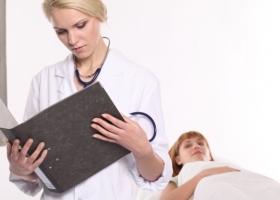October 9, 2012
- Solu-Medrol
- The price of dental paste Solkoseril
- How to take Duphalac for constipation?
- How to get rid of a headache
The endometrium - A tissue that brings a special sensitivity to hormones . Therefore, it is the general condition to a large extent determines the health of the nervous and endocrine systems of the body are women. If the operation of these systems, there are some glitches in the female body are observed pathological violations: failure of the menstrual cycle, changes in the endometrium, among which is often marked by endometrial polyps. This disease is dangerous for a woman's body, especially from the point of view of violations of the fertilization process. The fact is that the polyps become an obstacle for the implantation of a fertilized egg.
Features of polyposis
Previously, doctors have noted that endometrial polyps and cervical canal of the cervix is typical, especially for women who have given birth to children. Consequently, the occurrence of polyps associated to some degree with delivery . But nowadays often polyposis ovary develops in young girls and adolescents, as well as in women who have reached menopause. It is important to take into account that this disease can be diagnosed only in the process of examination by a gynecologist, because the occurrence of visible signs of the disease does not provoke.
Reasons polyposis
Uterine endometrial polyps - is the emergence of multiple polyps that develop on the endometrium of the uterus, and the cervix channel tsevikalnom. The disease occurs in women for different reasons. But the most common cause of this disease is still considered a violation of the hormonal ovarian function. The result is the development of hormonal imbalance focal hyperplasia (ie, proliferation) of the endometrium of the uterus, which is manifested in the form of polyps. Inflammation, which develop in the pelvic cavity, turning into a chronic form, abortion Carried out surgically, curettage of the uterus can also cause the formation of endometrial polyps. Most often the disease develops in women who suffer from metabolic disorders in the body, obesity . Diabetes , In patients who are at hypertension .
If after birth, miscarriage or abortion of the uterus was not completely removed the placenta, the formation of the so-called placental polyps. In the upper and middle area of the cervix the cervical polyps develop.
Symptoms of endometrial polyposis
 Endometrial Polyps and distinguished according to their histological structure. They can be glandular . glandular-fibrous . fibrous . In the latter case, polyps are not modified under the influence of hormones.
Endometrial Polyps and distinguished according to their histological structure. They can be glandular . glandular-fibrous . fibrous . In the latter case, polyps are not modified under the influence of hormones.
In most cases of endometrial polyps in women occurs without visible symptoms. One of the possible signs of the disease may be a manifestation of disorders of the menstrual cycle. If developing endometrial polyps and polyps grow to considerable size, then women may periodically occur strong bleeding , The frequent repetition of which may develop anemia. Hemorrhagic anemia appears strong sense of weakness, dizziness Loss of appetite.
Such bleeding may be repeated as a cycle (during the period), and acyclic, i.e. spontaneously. If there is a cyclical bleeding is profuse discharge during menstruation or immediately appear, or the second or third day of menstruation. Bleeding may continue for seven days or more. And in some cases, a woman suffering from almost always does not stop bleeding.
If a woman appears acyclic bleeding is usually copious blood occurs after a long delay menstruation. This delay may last six months or more.
Provided that women with endometrial polyps menstrual cycle takes place without delay and disorders as symptoms of the disease can manifest small sukrovichnye allocation between menstrual periods. In some cases copious cables .
Another important symptom of polyps endometrial cancer - women infertility Arising as a result of such formations.
Diagnosis of the disease
 To diagnose endometrial polyps is relatively simple, but it should be noted that the disease is detected mainly in preventive examinations. Informative in this case a cervical examination conducted with the use of mirrors and colposcopy . Furthermore, endometrial polyps detected during the course of ultrasound of the pelvic organs. But for the final specification of the diagnosis it is important to conduct hysteroscopy . If during the diagnosis determined by the presence of glandular or glandular-cystic polyps, their removal can be carried out depending on the doctor's recommendations. But in the presence of atypical polyps, which are considered a precancerous condition, such education should be removed immediately.
To diagnose endometrial polyps is relatively simple, but it should be noted that the disease is detected mainly in preventive examinations. Informative in this case a cervical examination conducted with the use of mirrors and colposcopy . Furthermore, endometrial polyps detected during the course of ultrasound of the pelvic organs. But for the final specification of the diagnosis it is important to conduct hysteroscopy . If during the diagnosis determined by the presence of glandular or glandular-cystic polyps, their removal can be carried out depending on the doctor's recommendations. But in the presence of atypical polyps, which are considered a precancerous condition, such education should be removed immediately.
When endometrial polyposis patient often administered a diagnostic uterine curettage for histology obtained material. This technique is used for the diagnosis and treatment of disease.
Pregnancy and endometrial polyps
Polyposis endometrial smears often has a significant impact on the ability to endure pregnancy and give birth to a healthy baby. As indicated above, often a consequence polyposis hormonal disturbances, which, in turn, become a cause of female infertility.
Therefore, normal pregnancy is very important to the timely and correct treatment of endometrial polyposis. To this end, action is being taken to restore the optimal hormonal balance, and then made the removal of polyps. After a certain postoperative period a woman can plan pregnancy.
In that case, if a woman has become pregnant in the presence of endometrial polyposis, she should know that polyps are not dangerous to the developing fetus, even if they are large enough. As a rule, doctors delay treatment of endometrial polyposis on the post-natal period. But if there is such a need, removal or treatment of polyps produced in the first months of pregnancy. Women who used to diagnose this disease and were treated polyposis, endometrial, it is necessary after the birth of the baby is required to undergo a thorough check so as not to miss the re-occurrence of polyps, as during pregnancy polyps occur in women who are prone to this disease, often enough.
Treatment of illness
 Patients who have been diagnosed with the disease, as a rule, carried out removal of polyps. This procedure is called polypectomy . It is carried out and to remove formation and for subsequent histological examination of material taken.
Patients who have been diagnosed with the disease, as a rule, carried out removal of polyps. This procedure is called polypectomy . It is carried out and to remove formation and for subsequent histological examination of material taken.
If the patient says relapsing form of endometrial polyposis, in this case should be scraping the lining of the uterus. By scraping it is commonly understood as the process of removing mucosal channel and the body of the cervix, which was carried out as for the treatment or for diagnosis. Often as a diagnostic method practiced by scraping the mucosa separation channel body and cervix.
After the removal of a polyp produced cryosurgery (freezing), the bottom of his feet. If a polyp is night located near the external os of the cervix, in that case held her wedge excision. After this procedure should be followed by a complete scraping the mucous membrane of the cervical canal. If polyps located in the cervix relatively high, for precise control of the process operations is applied hysteroscope.
Doctors recommend spending scraping the mucous membrane is already after a polyp has been completely removed. The fact is that in many cases the development of polyps occurs hyperplasia endometrial and endocervical (so-called mucous membrane of the uterus and cervix). During the cryoablation base significantly reduced the risk of polyp recurrence of polyps. In general, after again scraping polyps develop in approximately 10% of cases.
Scraping produced exclusively in the hospital. Pre-made preparations for this intervention, similar to the preparation of any other abdominal surgery. It is impossible to carry out this procedure in acute inflammation of the genital organs, as well as in suspected perforation of the uterus, abortion occurred. After this procedure a few days should regularly monitor the body temperature, as well as the general condition of women and the emergence of discharge from the genitals. In the postoperative period can not take a bath, avoid serious physical activity, supercool. Sexual life can not be practiced for several weeks.
Once a woman is discharged home, she periodically visits the gynecologist for routine observation. In addition, should immediately seek medical help in case of bleeding, pain in the abdomen, disorders of the menstrual cycle.
Prevention polyposis
To prevent the development of this disease, you should regularly be inspected by a specialist gynecologist, to plan a pregnancy, to prevent obesity, as well as strong emotional turmoil and stresses .
No comments:
Post a Comment